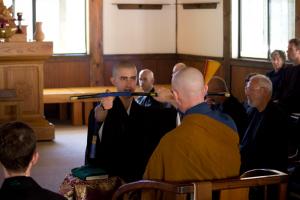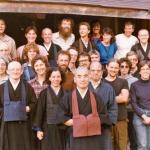 How does a Zen student know if a Zen teacher is a reliable guide, a verified representative of the Zen tradition?
How does a Zen student know if a Zen teacher is a reliable guide, a verified representative of the Zen tradition?
A Zen teacher claims authorization within the tradition and encourages students to give time, heart, and financial resources to the Zen project. But because we don’t know what we don’t know, how is a student going to assess their teacher’s authenticity? Well, you could trust your gut. However, the gut can go wrong. Buddha cited intuition as one of the several things that could turn out one of two ways – you can be right or you can be wrong.
Why is it important to work with an authentic teacher?
I’d say, primarily, so that practitioners can plumb the depths of this way of awakening and live accordingly with the best guidance possible.
In addition, as James Myoun Ford Roshi writes,
“For a surprising number of people, and it seems increasing, the mythic qualities of ‘dharma transmission’ have become a major seducer, with people seeking and obtaining titles without either significant training, nor, even more sadly, insight. Add in those who just make up titles and, well, there is a jumble of thorns for people to navigate if they’re hoping to practice Zen.”
Background
For more than a decade, the Soto Zen Buddhist Association (SZBA), of which I’ve been a member since the 90’s, has been working on this issue. The group came together with the promise of becoming something more than a collegial group. Led by the late Kyogen Carlson and others, the vision was to create a professional association, a Soto Zen denomination, that would support ethical practices and provide some verification of a teacher’s training in order to help teachers and students alike.
Granted, it is dicey territory. Zen teachers, and rightly so, are quite sensitive to any qualification of the teacher’s power to give dharma transmission to whomever they view as appropriate. Fortunately, the SZBA has been careful not suggest that we abridge a teacher’s authority, but that for membership in a professional organization, more is required. If we are to move in the direction of creating a profession of Zen teacher, then as with other professions in this culture, there are training standards that involve joining a community of similarly trained people who assess if an applicant is qualified. This is an important move from one person authorizing a new teacher to a group’s recognition of a candidate’s qualifications.
Presently, the only qualification for joining the SZBA is that a candidate has dharma transmission in a recognized Soto lineage. Therefore, membership in SZBA says only that one person with dharma transmission offered it to another. And because there is a wide range of what is required in Zen training, both in terms of the process and the outcome, this really doesn’t say much. And it seems to be saying less and less.
So, Zen students, you would do well to cut through the mist of the “mythic qualities of dharma transmission,” and pay attention. This, however, as I said above, is tough when you don’t know what you don’t know.
Here is what the SZBA board is now proposing:
(Proposed) Standards Required for Full SZBA Membership
- Five years of intensive priest formation with a teacher
- At least one twelve-week practice period or, alternately, four three-week intensive practice periods
- At least fifteen full sesshin-days per year during five years of priest training
- Dharma transmission
- Ethics guidelines and procedures for conflicts, applicable to the teacher/member and to their sangha
- Service in the traditional Soto Zen position of shuso in a manner consistent with one’s lineage tradition
Before I discuss these standards, let’s take a step back: There are various approaches to assessments of this type that can be divided most simply into two: either focus on what steps (process) a person is required to take or what outcome the person is expected to have attained. The proposed SZBA standards focus on the first rather than the second. Although the second is really the point, of course, the first is much easier to quantify. The Japanese Soto system has a similar, although more robust, set of requirements, focussed on number of years (and number of ango) one spends in an approved monastery – again a “what steps” rather than “what outcome” approach.
How has this issue been dealt with in the past?
According to Jiang Wu in Enlightenment in Dispute: The Reinvention of Chan Buddhism in Seventeenth-Century China, the Chan community 17th century China was dealing with some of the same issues. The standards that they settled on (both Linchi and Caodong lineages) required a verified enlightenment experience and transmission in a person-to-person unbroken lineage. Transmissions that were claimed remotely, either in time or space, where not respected. And the handing off of a transmission by one teacher for another teacher to distribute later, “proxy transmissions,” were also suspect.
One prominent branch of the Linchi lineage began to dig into the Caodong lines and question both the “verified” nature of their enlightenments and their transmissions. It resulted in many nasty letters, books, and even a lawsuit that led to book burning and a warrant for the arrest of one of the protagonists. These dudes may have had enlightenment experiences but seriously lacked social skills! Later research by the Caodong folks revealed that the Linchi lines also had some questionable links.
There are a couple important points here. First, what is more important in a teacher of the Zen way of awakening than to have had a verified awakening experience? The modern koan curriculum seems to have been developed, in part, for just this purpose and it is very effective. However, not all lineages in Soto Zen, indeed a considerable minority, use a koan curriculum. In the nonkoan lines of Soto Zen, to my knowledge, there is simply no method of verifying an awakening experience. Even if the SZBA standards are accepted, if a teacher is a new member (others will be grandparented in), that just means they’ve checked off the boxes in the list, not that there has been any particular outcome – like awakening and learning to live with it.
Where do I stand?
At first I thought I’d vote against these standards. I was concerned that voting for them would affirm that the practice period and sesshin requirements are “intensive.” In my view, they are not. One ninety-day practice period (or four three-week sessions) and seventy-five days of sesshin sets a very low bar – far too low by a factor of about five for someone to lead others in these practices.
I’ve been surprised to see in the listserve discussions that many see the standards as too high.
So although I view the proposed SZBA standards as setting a very low bar, I’ve decided to vote for a low bar – better, I hope, than no bar. For those who train with us here in Nebraska, we will offer what we think fitting – a much more rigorous process with equally rigorous attention to outcome.
——–













